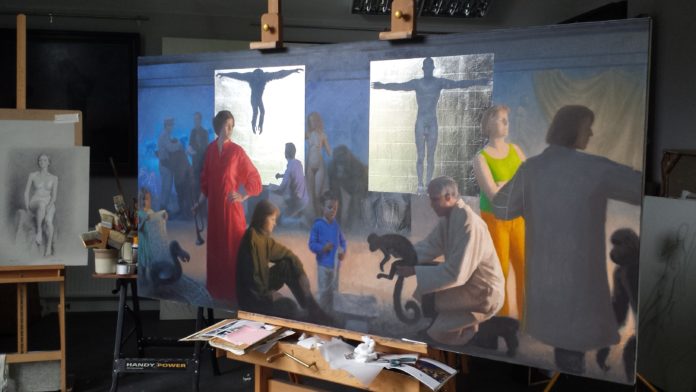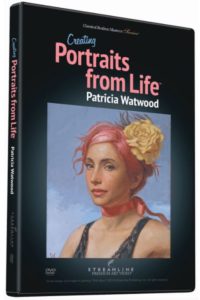Conor Walton discusses three of his narrative paintings. He says, “All my paintings are attempted answers to the three questions in the title of Gauguin’s famous painting: ‘Where do we come from? What are we? Where are we going?’”
The Enemies of Progress
BY CONOR WALTON
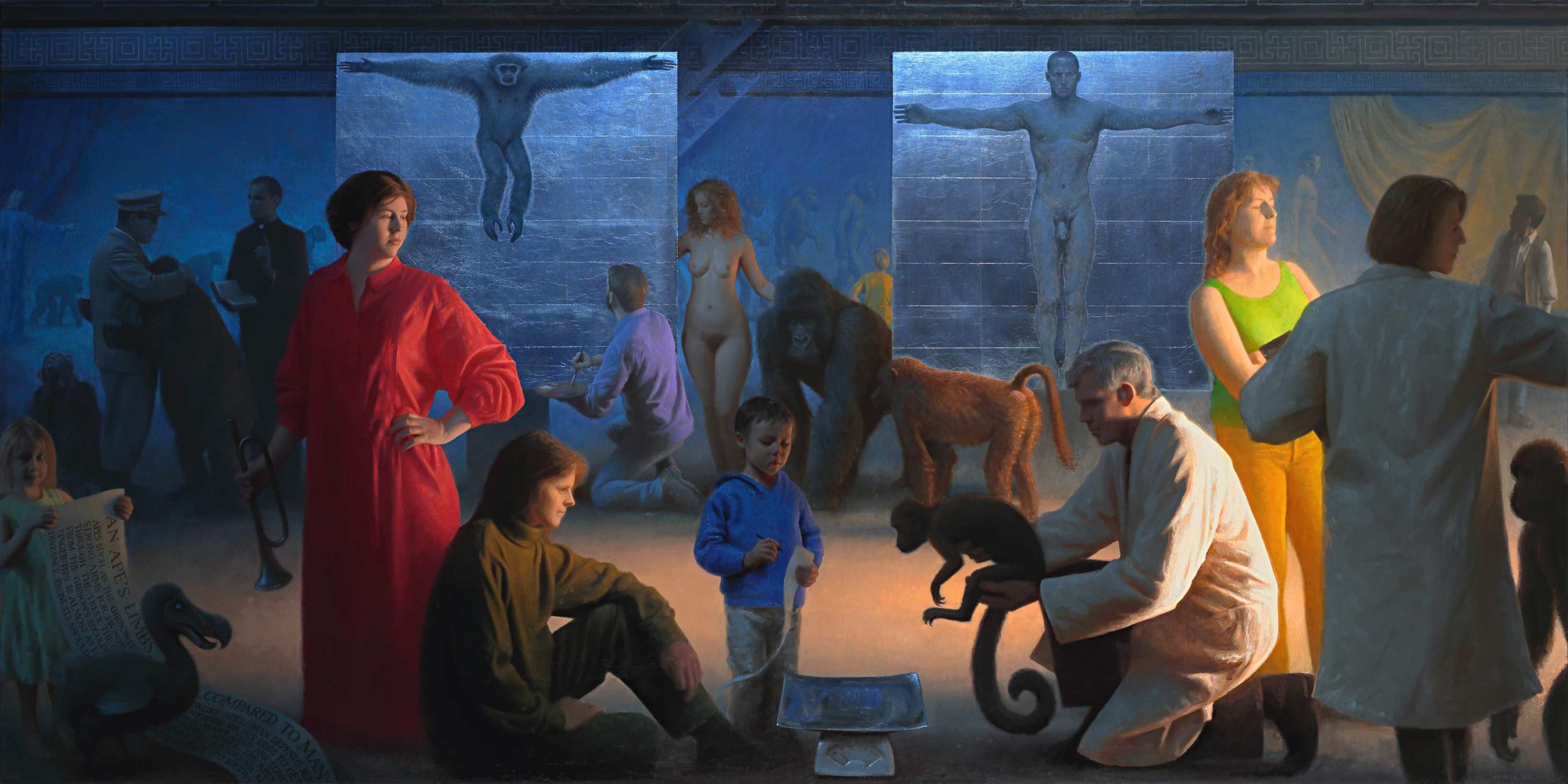
“An Ape’s Limbs Compared to Man’s” is based on an illustration in an old book about primates comparing the proportions of a human and a gibbon. The illustration intrigued me because it was based on the image of Vitruvian Man made famous by Leonardo, in which man’s beauty and perfection of form are demonstrated by him fitting, arms outstretched, within a perfect square.
The poor gibbon is obviously deficient within this scheme of values, and with his legs dangling, resembles a crucified martyr. The illustration seemed to express unintentionally something strange and dysfunctional in our relationship with nature.
I decided to try and fulfil the iconographic potential of the image by translating it into a dramatically lit three-dimensional space, a sort of Last Judgement scene in which, instead of human souls, animals are weighed and measured and man appears god-like, glorified.
In the background the evolution of ape to man progresses toward an unknown future. By overlaying the iconography of science and progress upon older traditions of Christian and classical humanistic iconography, the picture condenses many of the central themes of western civilization. The result is like a super-history painting that parodies Christianity, Humanism, and Scientism without, I think, endorsing any of them. I think this reflects my own ambivalence about much of our cultural heritage and likely destiny.
The people in the painting are not really free agents: they enact roles not of their choosing but dictated by my iconographic scheme. However, as realistic, sensitive portraits—mostly of friends and family—I think they help to counterbalance the abstractness of the “big picture” themes (Man, Nature, Science, Destiny) with more immediate human values.
In its composition, rich colors and dramatic light, the picture recalls High Renaissance religious and narrative painting. I also looked to Last Judgement scenes or “Dooms,” where Christ “in glory” is depicted centrally, while below him angels weigh the souls of the dead, separating the righteous from the damned.
The imaginary space was inspired by Courbet’s Atelier in the Musée d’Orsay in which he depicted himself at his easel in a vast urban studio, surrounded by models, animals, children, friends and enemies. I was also thinking of Gauguin’s great painting, “What Are We? Where Do We Come From? Where Are We Going?” (D’où Venons Nous / Que Sommes Nous / Où Allons Nous) and wanted to paint a picture that might live up to the ambition of his title.
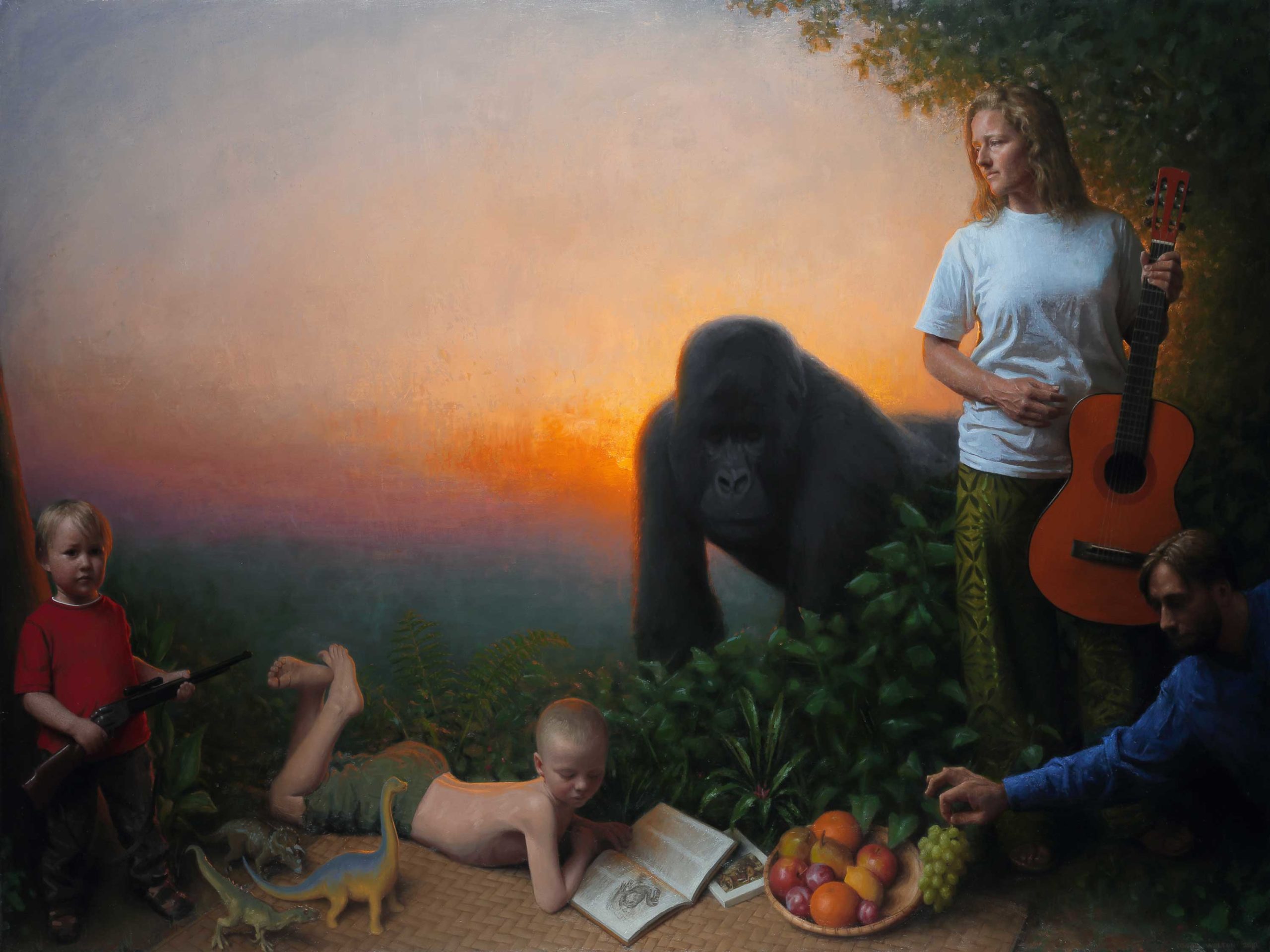
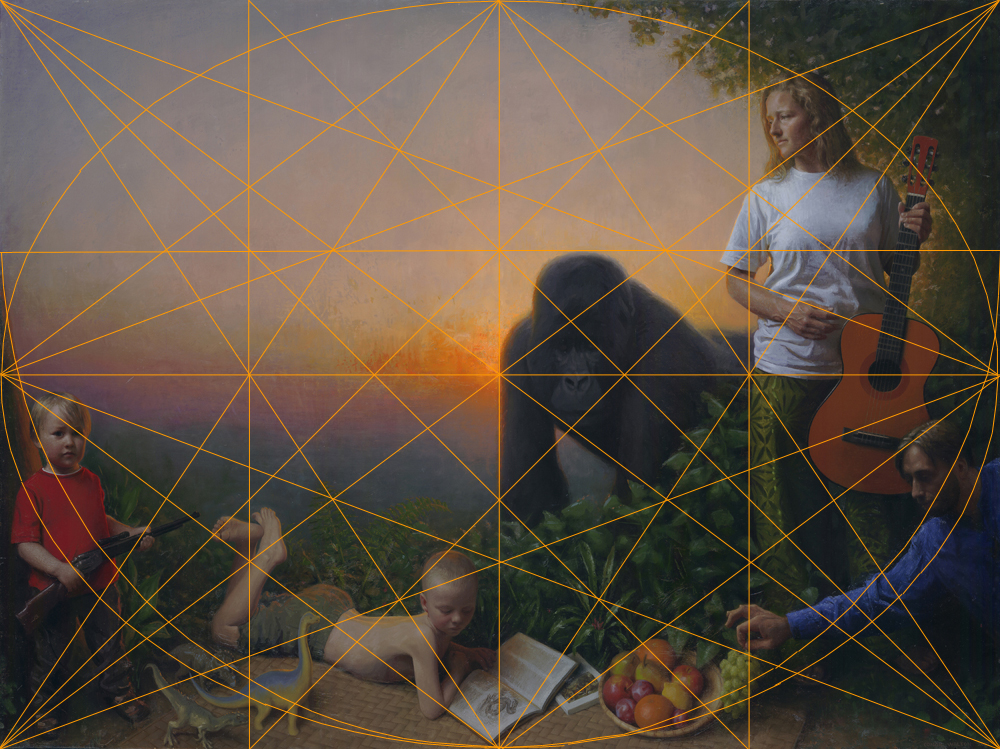
“Et in Arcadia Nos” is a family portrait among other things. I actually started painting my partner Jane in before any of our children had arrived; the boys slowly found their places in the picture as it evolved, but by the time our youngest child came along I had run out of space. We sometimes joke that she’s the gorilla.
The title (“We too are in Arcady”) is a reworking of “Et in Arcadia Ego,” the name of Poussin’s famous painting: “I too am in Arcady” (the “I” referring to Death). Changing the “I” to “We” in my picture underlines its family aspect, but it is also intended to draw viewers into the painting’s world, to implicate them in its situation.
Arcadia stands for a mythical golden age of humanity, a paradise in which nature was so abundant and life so simple that there was no need for intelligence or foresight. The Arcadians thus lived in a state of childlike innocence; a perpetual present, without fear, unaware even of their own mortality. In Poussin’s painting some Arcadians have come across a tomb and, deciphering its motto, for the first time comprehend their fate.
One might argue that, in terms of affluence and life expectancy, humans have never had it so good: if any time can be called a Golden Age surely it is ours. But our affluence has also bred a childlike optimism, a disconnection from the harsher facts of life and the harder lessons of history.
Ignoring these, we sow the seeds of our own destruction. Project figures for carbon dioxide emissions, natural resource consumption, habitat loss and extinction of species into the future, and the numbers seem to anticipate a vast tragedy: “I too am in these numbers.”
I remember a friend bursting into tears at the sight of her sister in one of my paintings. Transformed by my Old-Master-ish style, her sister’s image seemed to be lifted out of the present, to belong to the past, as if she was already lost. Seen for the first time, the painting seemed like a premonition of death, a memento mori.
“Et in Arcadia Nos” is a sort of family memorial, anticipating our deaths, perhaps even our extinction as a species. It presents an image of a more harmonious relationship with Nature, but it’s not intended to be a very realistic one. It’s more like a repository of transient pleasures and loves; of unfulfilled hopes and dreams.
It shows how we would have liked to have lived, but failed. Somehow the nostalgic, regretful, elegiac sensibility that goes with this type of painting seems entirely appropriate.
Related Article > The Narrative Paintings of Steven Assael
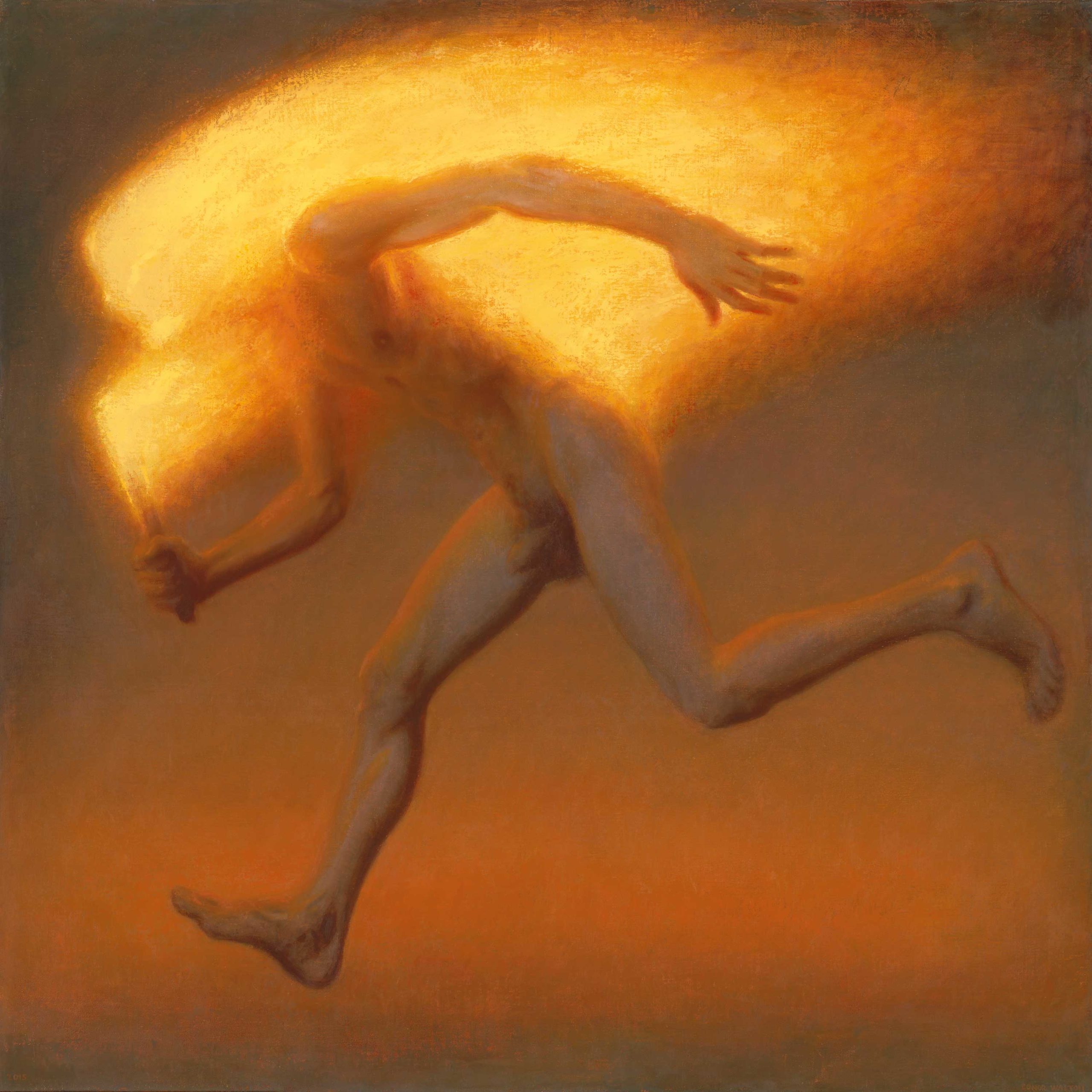
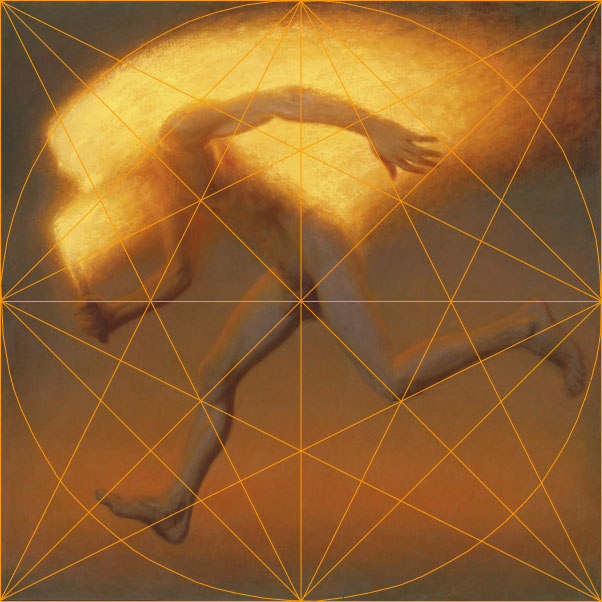
The idea for “Burning” originated in a project to paint personifications of the classical elements. The element of fire was the only one that—rather literally—took legs and ran.
Doing justice to the subject has become an obsession, leading me through several versions; standing to begin with, but becoming ever-more dynamic.
I’m rather proud of the compositional strength and dynamism of this version, built so firmly on the diagonals of the square, and centered on the groin—the fulcrum of the figure’s energy.
As for the disturbing, demonic character of this figure, I’ve had very mixed feelings about it. Sometimes images emerge that are compelling but leave one at a loss to understand the source and nature of their power.
He may be an image of human evil, or perhaps an expression of our modern zeitgeist with its apocalyptic nightmares of global warming. I thought of calling him Lucifer—“Light-bringer”—but became wary the moral judgments such a title might inspire. More recently I’ve come to see a perverse joyfulness in this figure that, in truth, I admire. Perhaps, for me, certain aspects of painting itself are bound up with his incandescence. He has to spread his flame, to set others alight.
Exhausted artists are sometimes described as “burnt out:” this fellow isn’t.
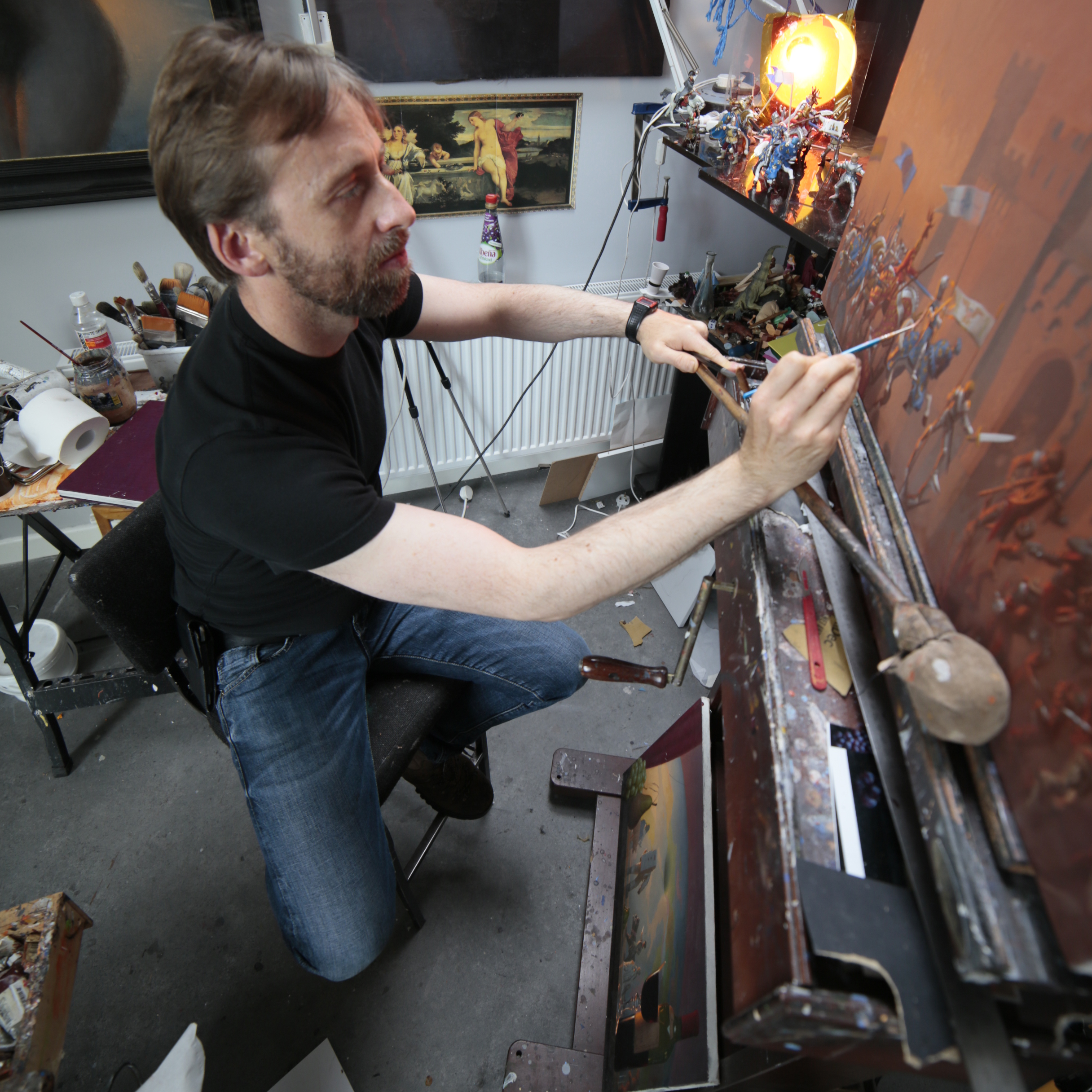
Connect with Conor Walton:
Website | Instagram
This article was originally published in Artists in Art (2015)
From our Sponsor > Preview Patricia Watwood’s Streamline Premium Art Video Workshop, “Creating Portraits From Life” here:
Discover How to Create Beautiful, Expressive, and Lifelike Portraits
This 8 Hour video tutorial shows a complete portrait demonstration and teaches you how to break down the complex process of creating a portrait into three basic steps of a charcoal drawing, an underpainting in 3 colors, and then a final pass in full and naturalistic oil colors. Learn the classical techniques of the French Academy with a modern palette and contemporary style. Start here with “Creating Portraits From Life” with Patricia Watwood.


